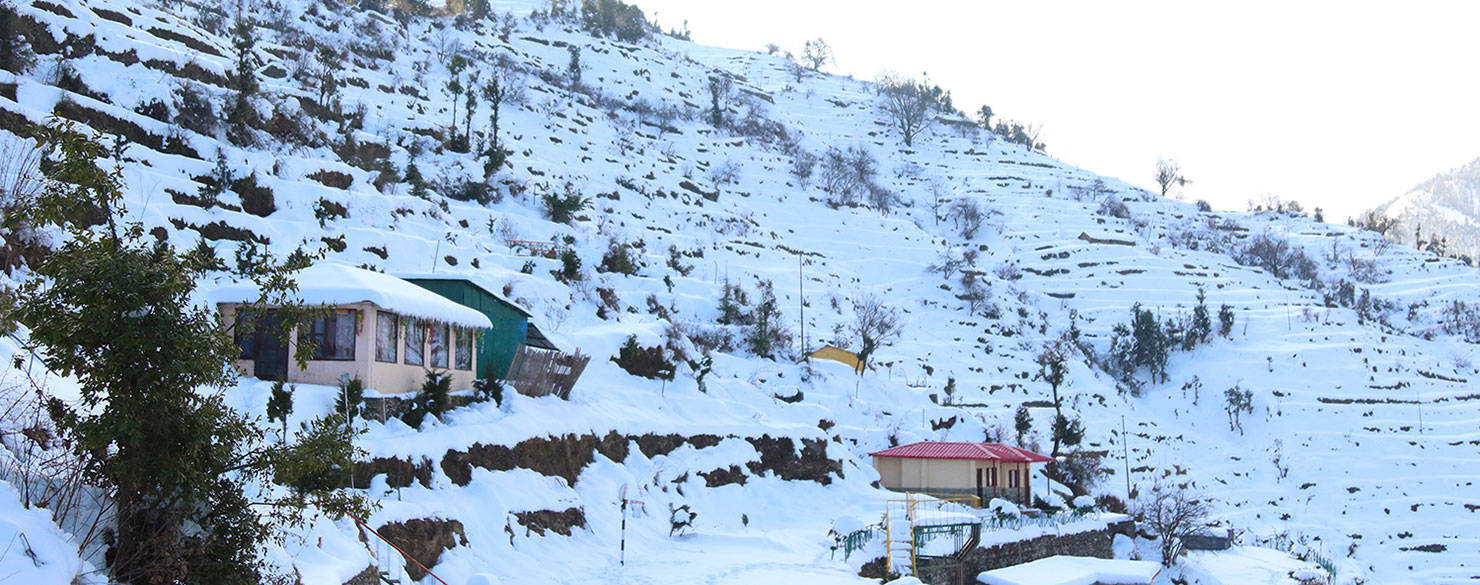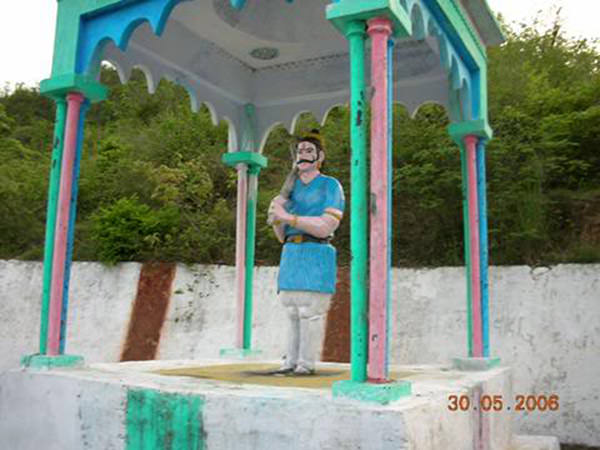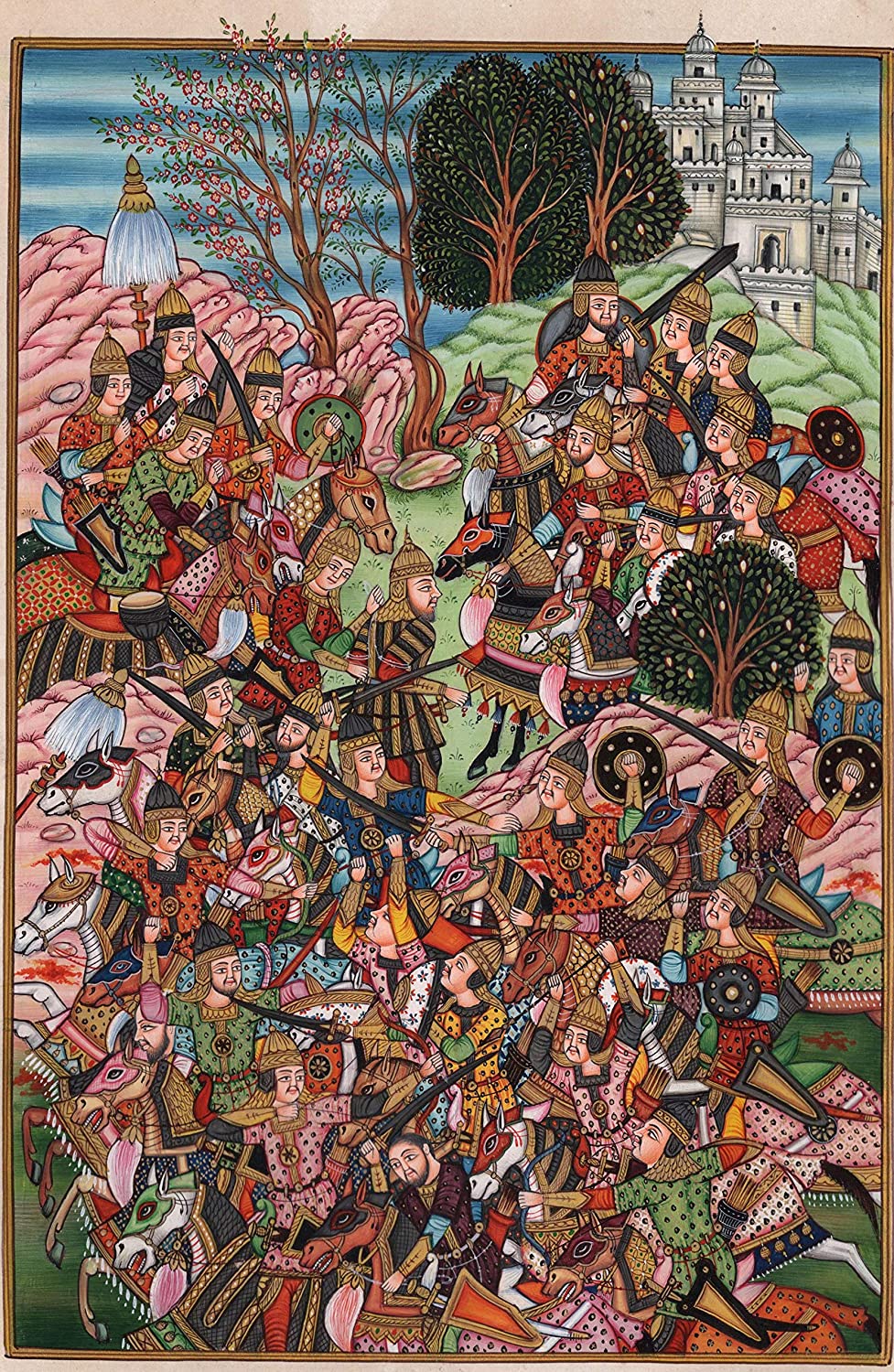More Coverage
Twitter Coverage
Satyaagrah
Written on
Satyaagrah
Written on
Satyaagrah
Written on
Satyaagrah
Written on
Satyaagrah
Written on
Join Satyaagrah Social Media
"Nak-Kati-Rani": Defying Shah Jahan, Rani Karnavati of Garhwal inflicted unprecedented humiliation on the Mughal army, cutting off their noses; her invincible spirit remain unsung in mainstream history, overshadowing the grand tales of emperors

Amongst the many flaws in the teaching and writing of Indian history is the fact that we have been obsessed with the exploits of the invaders rather than the deeds of the brave defenders. This is a bit curious, unique and sad, because in most countries one finds that the defenders have been glorified even if they were defeated in war. The problem gets compounded in India by the fact that we tend to ignore the history of the regions far away from Delhi or the big cities.
What is even a greater tragedy is the fact that the role of women in Indian history hardly (or if they do) finds passing mention in the textbooks in schools. There is a lot of talk on the empowerment of women these days– but I fear that it is confined to the drawing rooms of the elites in the big cities. To empower women without just paying lip service to the idea, we must begin by highlighting at the grassroots level the deeds of our brave women who lived in the past.
India has had outstanding women who strode the historical canvas like Colossus. True, we have heard of Rani Laxmibai of Jhansi and Razia Sultan. Their status has rightfully been elevated to that of celebrities – movies and songs have been made and sung about them.
However, how many of us have heard of the other brave women warriors? Maybe a few have heard of Rani Durgavati of Gondwana, Rani Karnavati of Chittor, or Rani Tarabaithe, indomitable queen of the Marathas. Hardly anyone of us have heard of Rani Abbakka Chowta of Tuluva, Rani Chennamma of Kittur, Rani Mangammal of Madurai, Rani Rudrama Devi of the Kakkatiya Dynasty, Rani Velu Nachiyar from Sivagangai, Bibi Sahib Kaur of Patiala, Chand Bibi of Bijapur….the list is exhaustive.
 |
Today we will be reading about an outstanding woman warrior from the region – Garhwal. The Garhwal Kingdom was founded in 823 by Kanak Pal. By 1358, the ruler Ajay Pal had expanded its territories by capturing the 52 “Garhs”, (forts, some historians trace the name of “Garh”wal to the capture of these forts) with the capital at Devalgarh not far from Srinagar, where it was later shifted to, by the dynamic ruler Mahipat Singh who ascended the throne in 1621.
Garhwal! The very utterance of this term will transport you to the Himalayas and to the abode of Mahadev. The worship of Mahadev is predominant in this region. The historicity of this region dates back to antiquity, much beyond the Mahabharata and the Ramayana periods. This region is believed to be the place where the Vedas were compiled and the Mahabharata written. Amongst the earliest known kings in BCE was Kanak Pal, who ruled Garhwal from 823 BCE.
Karnavati was the queen of Mahipat Shah, the ruler of Garhwal, who reigned from 1621 to 1631 CE. Mahipat Singh lived by the sword, and died by the sword in the year 1631 on the battlefield, fighting with Kumaon, leaving the reins of the Kingdom to his wife Rani Karnavati (not to be mistaken with Rani Karnavati of Chittor).
He died while fighting against the Raja of Kumaon. According to the book Garhwal Himalayas: A Study in Historical Perspective by Ajay S. Rawat, Jesuit missionaries were active in the Himalayan region during this period. Their objective was to spread Christianity. Few wrote about the historicity of the places they stayed and visited. According to Azevedo, a Jesuit missionary appointed by the ‘Society of Jesus’ in Agra in June 1628 for the Mogor Mission to the Himalayas, Mahipat Shah died in 1631. Azevedo went to Tsaprang via the route of Srinagar in Garhwal. He wrote that he was witness to the funeral of the king of Garhwal, Mahipat Shah in 1631.
Rani Karnavati or Naak Kati Rani of Garhwal as she is called! She was more popular as the Naak Katne Wali Rani and invaders dreaded waging war against her. She became the ruler of the Garhwal region as the Queen Regent from 1631 till her minor son, who was then aged 7 years, became an adult. She not only ruled wisely but also protected the Garhwal borders and repulsed all attacks. A major attack was carried out by the Mughals in 1640. Under her leadership, the Mughals were not only badly defeated, but also humiliated. She cut the noses of the surviving Muslim soldiers and created terror amongst them as well as in the Mughal court.
When Raja Mahipat Shah died, his son, Prithvi Pat Shah, the heir to the throne, was only seven years old. Rani Karnavati took over the reins of the Garhwali kingdom on behalf of Prithvi Pat Shah. Though contemporary inscriptions mention her name as Maharani Mata Karnavati, she was more popular as Naak Kati Rani after she successfully repulsed a Mughal attack and chopped off the noses of the surviving invaders. Folk songs in Garhwal since that period to this day glorify the queen on her bravery exhibited against Muslim invaders.
Many secular historians say that Rani Karnavati didn’t rule Garhwal. But there are inscriptional evidences confirming her rule. A copper plate inscription of Samvat 1697 corresponding to 1640 CE of the Gregorian calendar is related to Rani Karnavati of Garhwal. She released it on behalf of her son Maharaja Prithvi Pat Shah. The copper plate confirms grant of land to the Hatwal Brahmins in Haat village of Chamoli district of Garhwal. One of the witnesses to this grant was Madho Singh Bhandari, one of the three brave generals in the Garhwal army.
 Legend of Madho Singh Bhandari |
The Mughal rule in India had no impact on Garhwal. Mahipat Shah was an independent ruler. He had three brave generals in his army — Madho Singh Bhandari, Rikhola Lodi, and Banwari Dass. Lodi had led successful war expeditions against the Tibetans and other kingdoms. There was a saying regarding the valor of Madho Singh Bhandari in the Garhwals — “There are only three ‘Singhs’ on this earth, one is the lion, the second is the cow’s horn and the third Madho Singh”.
"एक सिंह वन का सिंह, एक सींग गाय का। तीसरा सिंह माधोसिंह, चौथा सिंह काहे का। "
Such brave generals continued to command the Garhwali army, first under Mahipat Shah and then under Rani Karnavati. Madho Singh died in the battle of Chotta Chini against Tibetans in 1640 CE. After his death, Rani Karnavati banked upon another brave Garhwali soldier. He was Dost Baig, an artillery officer in service since the time of Mahipat Shah. The queen appointed him as the commander. At the time of Mughal invasion, Dost Baig was the commander of the Garhwali army.
 Mughal Emperor Shah Jahan |
In 1640, Mughal Emperor Shah Jahan sent a huge army to invade Garhwal. 30,000 horsemen under the command of General Najabat Khan started their march towards this Himalayan region. Shah Jahan was aware that a minor ruler under a queen Regent ruled Garhwal. As most Mughal expeditions in subjugating kingdoms and bringing them under Mughal rule were a success, bringing Garhwal under Mughal supremacy was his objective. His aim was to further establish his supremacy in the Himalayan region.
Rani Karnavati had spies in the borders of her territory. She was alerted of the advancing Mughal army towards Srinagar.
According to Manucci, an Italian traveller who has written about the war, the Rani allowed the forces of Najabat Khan to advance and penetrate into the mountains up to a distance, after which she closed the roads from the way they came!! They could not go back and they did not know the mountainous terrain well enough to advance forward quickly. The spider had drawn the fly into its web.
Garhwali forces checked the Mughal army ahead of their reaching the capital. A fierce battle ensued between the two parties. Garhwalis were proficient in fighting in hilly terrains, which the Mughals lacked though they were well equipped with weaponry. Garhwali forces soon started decimating the Muslim army. Witnessing that defeat was imminent, few of the Mughal soldiers fled the battlefield. In no time Mughals witnessed a crushing defeat. Many of them were butchered in battlefield.
Rani Karnavati humiliated the surviving Mughal soldiers in the battlefield. She wanted to teach the Mughals a lesson so that they never invaded her territory in the future. She chopped off the noses of the Mughal soldiers including Najabat Khan, the Mughal general. Rani Karnavati resorted to psychological warfare by sending a message to the Mughal court that if she could chop off their noses, she could also chop off their heads. The sultan was embarrassed and enraged. He ordered another attack under Areej Khan who met the same embarrassment under the hands of the brave Rani.
The surviving soldiers were let free after their noses were cut. They tried to force their way back to the Mughal kingdom, but many of them were encircled and killed on the way by the Garhwali soldiers. Very few soldiers including Najabat Khan survived on the leaves and roots of trees in the mountainous jungles to reach the Mughal court. They narrated their saga of horror and torture to Shah Jahan. The Mughal emperor demoted Najabat Khan for bringing shame to the Mughal emperorship.
 |
Since then, Rani Karnavati came to be known as Naak Katne Wali Rani and later Naak Kati Rani. The above incident is not only written about by Mannnuci but by chroniclers like Bernier, Tavernier and Shah Nawaz Khan.
The Mughals including contemporary rulers of neighboring kingdoms and people started knowing her by her nickname and not her original name.
Many Indian kings followed the rules of Dharma and pardoned not only the prisoners of war but also the invading Muslim rulers. Prithviraj Chauhan pardoned Mohammed Ghori every time he was defeated in battle and begged for mercy. Ultimately in the 16 th battle, Ghori defeated Chauhan and the outcome is known to all. Muslim rule in India began after the success of Ghori in this last battle. King Prithu of Assam pardoned the Muslim prisoners of war and allowed them to settle which led to the first Muslim settlements in the northeast. Rani Karnavati was one of the counted few rulers who showed no mercy to foreign invaders. Due to her mercilessness, Mughals never dared to attack her kingdom again!
Mughal Darbaar ya Maasirul Umra, a translated book of Rani Karnavati’s contemporary times, describes about the brave feat of Rani Karnavati. This book mentions how the Rani gave a crushing defeat to the Mughal army. It says that the queen was responsible for humiliating the Muslim army. The name of the Mughal general as Najabat Khan, who led the Garhwal expedition, also finds mention in this book.
|
The Garhwal region witnessed big developments during the reign of Rani Karnavati. She was instrumental in facilitating a number of hydraulic constructions, especially irrigation systems to the benefit of farmers. It prevented water from sinking underground as it exited the hill into the gravels leading to the valleys. Under her patronage, several temples were built. Another of her development activities worth mentioning was the construction of the Rajpur Canal, the earliest of all the Dun canals. This canal started from the Rispana River, a tributary of the Song River, and brought along waters to Dehradun city.
Few years later, the Garhwali queen’s grown-up son Prithvi Pat Shah ascended the throne of Garhwal. Rani Karnavati continued assisting her son in the administrative, military, and judicial affairs.
Garhwal, the land of celestial beauty, is the kingdom that the Mughals could never win, all because of the mercilessness shown by Rani Karnavati. Had all the kings of Bharat fought and were merciless like her, the History of the country would have been different! Hail the Garhwali queen Karnavati!
There is no doubt that Rani Karnavati was one of bravest women in Indian history. Sadly, hardly anyone knows about her. It’s time people who clink glasses and say “cheers” on listening about her exploits do something so that the younger generations can seek inspiration from a queen who was extraordinarily brave.
References:
https://www.quora.com/Do-you-know-about-the-Nak-Kati-Rani-of-Garhwal
garhwalpost.in - By Garhwal Post - Kulbhushan Kain
Saffron Swords: Centuries of Indic Resistance to Invaders - Manoshi Sinha Rawal, Yogaditya Singh Rawal
 Support Us
Support Us
Satyagraha was born from the heart of our land, with an undying aim to unveil the true essence of Bharat. It seeks to illuminate the hidden tales of our valiant freedom fighters and the rich chronicles that haven't yet sung their complete melody in the mainstream.
While platforms like NDTV and 'The Wire' effortlessly garner funds under the banner of safeguarding democracy, we at Satyagraha walk a different path. Our strength and resonance come from you. In this journey to weave a stronger Bharat, every little contribution amplifies our voice. Let's come together, contribute as you can, and champion the true spirit of our nation.
 |  |  |
| ICICI Bank of Satyaagrah | Razorpay Bank of Satyaagrah | PayPal Bank of Satyaagrah - For International Payments |
If all above doesn't work, then try the LINK below:
Please share the article on other platforms
DISCLAIMER: The author is solely responsible for the views expressed in this article. The author carries the responsibility for citing and/or licensing of images utilized within the text. The website also frequently uses non-commercial images for representational purposes only in line with the article. We are not responsible for the authenticity of such images. If some images have a copyright issue, we request the person/entity to contact us at This email address is being protected from spambots. You need JavaScript enabled to view it. and we will take the necessary actions to resolve the issue.
Related Articles
- Jhalkaribai: The Indian Rebellion Of 1857 Who Took on British Forces Disguised as Laxmibai
- Vinayak Damodar Savarkar – A Misunderstood Legacy
- A Great man Beyond Criticism - Martyrdom of Shaheed Bhagat Singh (Some Hidden Facts)
- Unsung Heroine Pritilata Waddedar, Who Shook The British Raj at the age of 21
- Letter to Shaheed Sukhdev 5th April, 1929 - Collected work of Shaheed Bhagat Singh and his Co-patriots
- Rana Sanga, the symbol of bravery who defeated Sultan Ibrahim Lodhi and fought Muslim Terrorists for Hindu Existence
- Hero of Pawankhind: Veer Maratha Bajiprabhu Deshpande, who led 300 Soldiers against 12000 Adilshahi Army defending Shivaji
- Our first true war of independence lie forgotten within the fog of time and tomes of propaganda: Sanyasi Rebellion, when "renouncers of the material world" lead peasants in revolt against British and fundamentalist islamic clans
- Santi Ghosh and Suniti Choudhury: Two Teenage Freedom Fighters Assassinated British Magistrate
- Cross Agent and the hidden truth of massacre of Jallianwala Bagh - Martyrdom of Shaheed Bhagat Singh (Some Hidden Facts)
- Saraswathi Rajamani, at 16, became the youngest and first female spy for INA, boldly recruited by Netaji in 1942, courageously spent two years spying on the British in Myanmar during WWII, a pivotal yet overlooked heroine in India's struggle for freedom
- Depth of Soviet penetration in Indian media is exposed through declassified CIA document from 2011
- Taimur was attacked and defeated by 20 year old Rampyari Gurjar and her army of 40,000 women
- Moplah Genocide of the Malabar Hindus, 1921: Thousands of Hindus slaughtered
- Tirot Singh: An Unsung Hero of the Khasi Tribe who destroyed British with his skill at Guerrilla Warfare
























